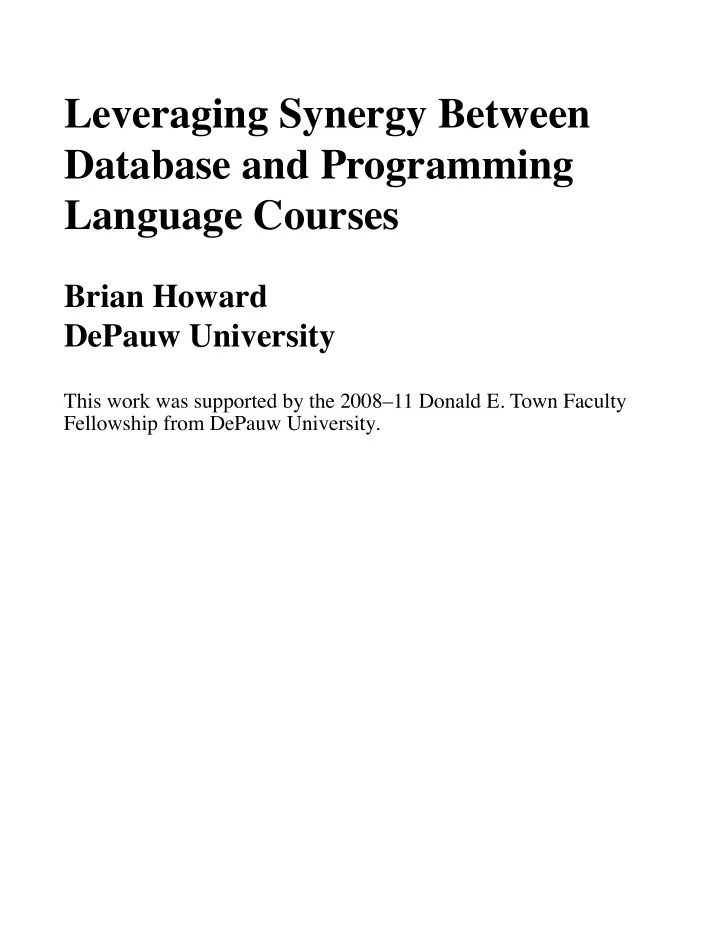

Leveraging Synergy Between Database and Programming Language Courses Brian Howard DePauw University This work was supported by the 2008–11 Donald E. Town Faculty Fellowship from DePauw University.
Motivation and Overview Enhance DB or PL course by building on connections with the other Examples: Syntax-Directed SQL Translation Comprehension Syntax Object-Relational Mapping Transactional Memory Document-Oriented Databases MapReduce
Syntax-Directed SQL Translation Grammar for a subset of SQL
Translation Functions
Example Translation What is the difference between a HAVING and a WHERE condition when there is no GROUP BY ?
Comprehension Syntax Generalized for loop, based on set builder notation Scala Example val mentorPairs = for { mentor <- students other <- students if mentor.year < other.year && mentor.major == other.major } yield (mentor, other) This is equivalent to val mentors = students.flatMap(mentor => students.withFilter(other => mentor.year < other.year && mentor.major == other.major ).map(other => (mentor, other) ) )
C# LINQ Equivalent var mentors = from mentor in students from other in students where mentor.year < other.year && mentor.major == other.major select new {a = mentor, b = other}; SQL Equivalent SELECT mentor.ID as a, other.ID as b FROM Student mentor, Student other WHERE mentor.Year < other.Year AND mentor.Major = other.Major;
Object-Relational Mapping Java Database Connectivity (JDBC) List mentors = new ArrayList(); Statement statement = connection.createStatement(); String query = "SELECT mentor.ID as a, other.ID as b " + "FROM Student mentor, Student other " + "WHERE mentor.Year < other.Year " + " AND mentor.Major = other.Major;"; ResultSet results = statement.executeQuery(query); while (results.next()) { String mentorID = results.getString("a"); String otherID = results.getString("b"); mentors.add(new MIDPair(mentorID, otherID)); } results.close();
Java Persistence API (JPA) @Entity @Table(name="Student") public class Student { @Id @Column(name="ID") private String id; // Primary key @Column(name="Year") private int year; @ManyToOne @JoinColumn(name="Major") private Department major; // Foreign key // usual constructors, accessors, etc. go here }
Java Persistence Query Language (JPQL) List mentors = new ArrayList(); String queryString = "select mentor, other " + "from Student mentor, Student other " + "where mentor.year < other.year " + " and mentor.major = other.major"; Query query = entityMgr.createQuery(queryString); for (Object result : query.getResultList()) { Object[] pair = (Object[]) result; Student mentor = (Student) pair[0]; Student other = (Student) pair[1]; mentors.add(new MPair(mentor, other)); }
C# LINQ to Entities var context = ...; var query = from mentor in context.students from other in context.students where mentor.year < other.year && mentor.major == other.major select new {a = mentor, b = other}; var mentors = query.ToList();
Transactional Memory class Fork { val inUse = Ref(false) } def meal(left: Fork, right: Fork) { // thinking atomic { implicit txn => if (left.inUse() || right.inUse()) retry // forks are not both ready, wait left.inUse() = true right.inUse() = true } // eating atomic { implicit txn => left.inUse() = false right.inUse() = false } } Example from ScalaSTM library documentation
Document-Oriented Databases JavaScript Object Notation (JSON) { "ID": "12-34567", "Name": "Ann O'Nemus", "Year": 2015, "Major": "Computer Science", "Home Address": { "Street": "123 Main", "City": "Springfield", "State": "AK", "ZIP": 98765 }, "Phones": [ {"Type": "Home", "Number": "555-555-1234"}, {"Type": "Cell", "Number": "555-555-5678"} ] }
MapReduce Example in MongoDB: count number of students per major/year var map = function() { emit({"Major": this.Major, "Year": this.Year}, 1) } var reduce = function(key, values) { var total = 0; for (index in values) total += values[index]; return total; } db.runCommand({ "mapreduce": "students", // source collection "map": map, "reduce": reduce, "out": "graduates" // output collection })
Recommend
More recommend